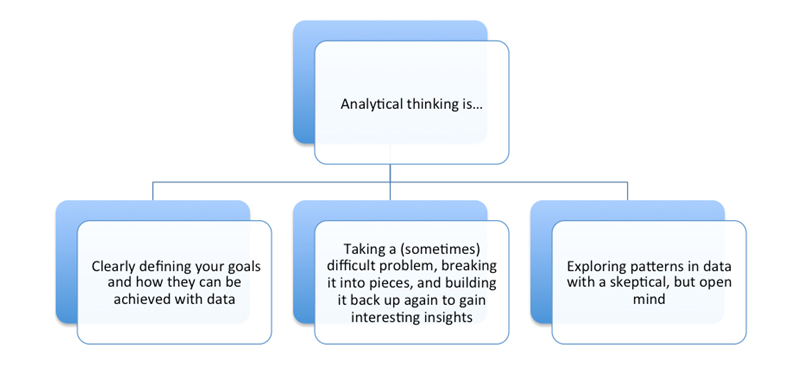Analytical Thinking in the Workplace and the Classroom
Why Analytical Thinking?
In 2014, ODI gathered an expert panel of professionals that work with big data. After 2 days of intense discussion, this expert panel developed a list of the knowledge and skills essential to working with big data. Their work was then validated by almost 100 peers who work as big data analysts. As you can see below, Analytical Thinking ranked highest in both the knowledge AND skills essential to being an effective big data-enabled specialist.
This left us wondering…what does “analytical thinking” mean? How does the analytical thinker approach work with data, and what does this look like in K-16 classrooms?
Our next step was to convene a data literacy workshop in 2015, in partnership with IBM. This workshop convened a panel of 12 professionals from both data-intensive industries and K-16 education, and provided a unique opportunity for education leaders to observe five panel members who work in data analytics as they held a “fishbowl” discussion about analytical thinking. The discussion was prompted by the following key questions: 1) What is analytical thinking within the context of your job? and 2) Can you provide an example of how you have used analytical thinking in your work? After listening to the conversation among data analysts, educators were invited to participate to ask clarifying questions and reflect on the implications for education.
The conversation was fascinating, and after the workshop I spent a great deal of time reviewing, highlighting, underlining, and taking notes from their recorded and transcribed discussion. Three key ideas emerged:

Implications for education
When education experts joined the discussion, the full panel articulated the following insights regarding the implications of what they had heard for education:
1) ENCOURAGE CURIOSITY, SKEPTICISM AND PERSISTENCE
- Encourage curiosity – how can you make sense of data and tell a story?
- Encourage questioning when something doesn’t “make sense”, particularly regarding the data itself and what it does/ does not represent.
- Allow students to fail. The idea that failing is part of the process of innovation.
- Allow students to struggle. Teach persistence.
2) GIVE STUDENTS HANDS-ON EXPERIENCE WORKING WITH DATA
- Teach them how to formulate productive questions that can be answered with data,
- Teach them how to break down a problem, thinking about the boundaries of the problem and variables, and encourage them to show their work.
- Teach them how to run controlled experiments
- Push them to identify multiple possible explanations for patterns in data
- Teach them to recognize and account for the limitations of data
- Have them grapple with ethical considerations associated with data collection and use.
Starting a Conversation
Do you work in data analytics? What do you think about the nature of analytical thinking and how it relates to your work? Do you remember how you developed the ability to approach problems this way?
Are you an educator? What are your ideas and experiences regarding teaching these skills to students?
Teaching students/training employees to think analytically is a challenging problem. It is my hope that we can pool our insights and ideas to tackle this challenge. Please share your thoughts below.
- rkrumhansl's blog
- Log in to post comments



 Ruth is the Founder of EDC’s Oceans of Data Institute. She is the principal investigator of the NSF-funded Oceans of Data and Ocean Tracks projects, and lead author of EDC Earth Science. Before joining EDC, Ruth was a high school science teacher, a chief scientist in environmental consulting, and a petroleum exploration geologist.
Ruth is the Founder of EDC’s Oceans of Data Institute. She is the principal investigator of the NSF-funded Oceans of Data and Ocean Tracks projects, and lead author of EDC Earth Science. Before joining EDC, Ruth was a high school science teacher, a chief scientist in environmental consulting, and a petroleum exploration geologist.